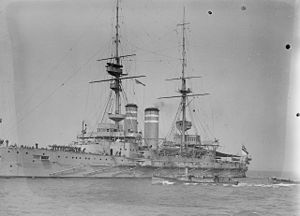
Back Queen (Schiff, 1904) German HMS Queen (1902) Spanish اچاماس کوئین (۱۹۰۲) Persian HMS Queen (1902) Finnish HMS Queen (1902) French אה"מ קווין (1902) HE HMS Queen (1902) Italian HMS Queen (1902) Portuguese HMS Queen (1902) Turkish
 HMS Queen, c. 1909
| |
| History | |
|---|---|
| Name | HMS Queen |
| Builder | Devonport Dockyard |
| Laid down | 12 March 1901 |
| Launched | 8 March 1902 |
| Completed | March 1904 |
| Commissioned | 7 April 1904 |
| Decommissioned | November 1919 |
| Fate | Broken up, 1921 |
| General characteristics | |
| Class and type | London-class battleship |
| Displacement | |
| Length | 431 ft 9 in (131.6 m) o/a |
| Beam | 75 ft (22.9 m) |
| Draught | 26 ft (7.9 m) |
| Installed power |
|
| Propulsion | |
| Speed | 18 knots (33 km/h; 21 mph) |
| Complement | 714 |
| Armament |
|
| Armour | |
HMS Queen was a member of the London class of pre-dreadnought battleships built for the British Royal Navy. The Londons were near repeats of the preceding Formidable-class battleships, but with modified armour protection. Due to slight differences between Queen and HMS Prince of Wales and the other Londons, they are sometimes referred to as the Queen class. The ship's main battery consisted of four 12-inch (305-mm) guns, and she had top speed of 18 knots (33 km/h; 21 mph). The ship was laid down in March 1901, was launched in March 1902, and was completed in March 1904. After commissioning in April 1904, she served with the Mediterranean Fleet until 1906, when she returned to Britain before embarking on another stint with the Mediterranean Fleet later that year. Queen was transferred back to the United Kingdom in 1908 and thereafter served in the Atlantic Fleet, the Home Fleet, and finally the 5th Battle Squadron of the Second Fleet in 1914.
After the outbreak of the First World War in August 1914, Queen, still part of the 5th Battle Squadron, initially served in the English Channel. After operations with the Dover Patrol, she served in the Dardanelles Campaign in support of the Allied landings at Gallipoli. She participated in the Landing at Cape Helles on 25–26 April and supported ANZAC forces ashore over the course of the following month. In late May 1915, Queen was withdrawn to reinforce the Italian fleet at the southern end of the Adriatic Sea after Italy joined the war on the side of the Allies. In early 1917, she was converted into a depot ship to support the Otranto Barrage and was disarmed over the course of the year. The ship returned to Britain after the war in early 1919, where she was briefly used as a barracks ship. Queen was sold for scrap in 1920 and was broken up the following year.